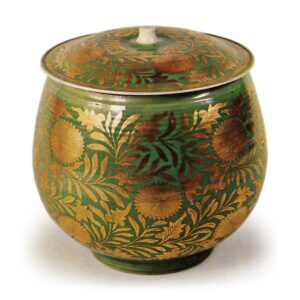
Born in Seto City in 1900. His real name was Hajime. He started his career as a designer after learning design from Atsushi Hino. In October 1926, he was invited to work as an engineer at the Gifu Prefectural Ceramics Experiment Station, and in October of the following year, after the establishment of the 4th Art and Craft Division at the 8th Imperial Exhibition, he continued to exhibit his works at the Bunkaichi Exhibition every time. 1928, he became an engineer at the local Ministry of Commerce and Industry. 1930, he became an engineer at the Ministry of Commerce and Industry, In 1930 (5th year of the same period), he visited China and Korea to observe the pottery industry, and in 1938 (3rd year of the same period), he was invited by the Governor-General of Taiwan to teach the local pottery industry there.
In 1940, he retired from government service and built his own kiln in Hiyoshi Kohoku-ku, Yokohama. In 1951, he was awarded the first Kanagawa Prefecture Culture Prize, and the following year the sixth Chunichi Culture Prize. In 1958, he withdrew from the Nitten and exhibited his work at the Japan Traditional Crafts Exhibition, where he was a member of the annual jury. 1959, three of his works were acquired by the Museum of Fine Arts, Boston, and he won the Grand Prix at the World Exposition in Brussels. 1961 (36), he became an important intangible cultural property holder of porcelain in overglaze enamel and also made wall panels for the Fukiage Palace of the Imperial Household Agency. In 1964 (39), he was sent by the Ministry of Foreign Affairs on a tour of European countries, Egypt, Turkey, the Philippines, Okinawa, etc. In 1965, he was appointed as an official of the People’s Republic of China.
In 1965, at the invitation of the People’s Republic of China, he toured Beijing, Xi’an, Zhengzhou, Nanjing, Shanghai, Hangzhou, Nanchang, Jingdezhen, Guangzhou, and other cities. In 1968 (43), he collapsed while working on a large decorative vase for the first ceremonial room of the new Imperial Palace. He was sixty-eight years old. He was active as a director of the Ceramic Society of Japan, and in cooperation with Kato Karakuro, another director, established the Ceramic Society of Japan Award to encourage younger generations. He also resolutely fought for the internal reform of the Japan Traditional Crafts Exhibition.



